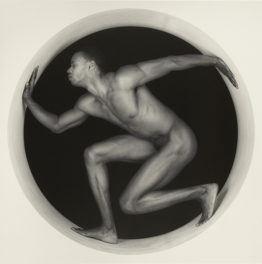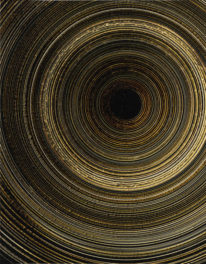
Vincent Beltran uses a microfading tester on a tapestry from the Getty Museum’s collection
Staff members of the Getty Conservation Institute (GCI) come from a great variety of disciplines. Chemists, architects, biologists, engineers, and other specialists lend their expertise to advance conservation of the world’s cultural heritage. Just as diverse as the staff’s backgrounds are the types of tools they use to aid the Conservation Institute’s conservation efforts.
The Getty Museum and the Getty Research Institute hold countless artworks worthy of display. However, due to the nature of the materials comprising many of these works, prolonged exposure to intense lighting conditions in galleries can lead to deterioration, including perceptible fading in color. Vincent Beltran, an assistant scientist at the Conservation Institute, works on preventive conservation projects, such as the Managing Collection Environments Initiative, which is studying how art objects respond to environmental conditions in museums, libraries, archives, and other repositories.
In order to measure color changes in light-sensitive works of art, Vincent performs what’s called microfadeometry.

Microfadeometry setup in a Getty Museum gallery displaying 18th-century tapestries
What Does the Tool Do?
A microfading tester focuses a tiny spot of very intense light on the artwork, instigating that spot to fade in color. At the same time, the instrument continuously records the change in color over the tested period of time.
Although microfadeometry is technically a destructive technique, the faded spot is less than half of a millimeter wide, practically invisible to the naked eye. Moreover, says Vincent, “because we monitor the color change simultaneously, we can stop the run once it exceeds a certain threshold so that it is not visible to the viewer.”
The accelerated fading results are then compared to the Blue Wool standards, a series of wool materials dyed with different colorants whose fading rates under museum levels of illumination are well known. Vincent uses these standards to interpret the microfading results and to predict how colors in the tested artwork will fade in gallery conditions over a long period of time.

A close look at the beam of light emitted by the microfading tester
How Does it Advance Conservation Practice?
By knowing whether and how an artwork is likely to fade, Vincent can recommend appropriate lighting conditions to the displaying institution to preserve their collections for the future.
Exposure to light is only one of the many environmental factors that can result in changes in the artwork, however. Vincent also takes a look at how temperature, humidity, exposure to oxygen, and many more variables in the ambient environment can affect works of art. Furthermore, he measures changes in not only color but also surface appearance, such as the gloss of a photograph.
In order to make sense of this huge amount of data, Vincent performs multivariate analysis (MVA). “Rather than one-by-one comparisons, the easier thing to do is put it in a statistical package that takes a look at all the different correlations and group the relevant variables on newly defined factors,” he explains. “Basically, we are trying to reduce the number of variables so it’s easy to see the correlations.”
Vincent is currently working with colleagues at the Getty Museum to assess the light sensitivity of tapestries hanging in the galleries. Aside from studying works of art, he also analyzes the vulnerability of artist’s materials, both current items in the market and historical collections of colorants.




Comments on this post are now closed.